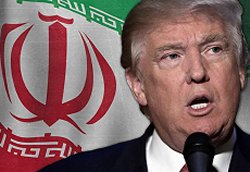
|
- Iran: Eight Prisoners Hanged on Drug Charges
- Daughter of late Iranian president jailed for ‘spreading lies’ - IRAN: Annual report on the death penalty 2016 - Taheri Facing the Death Penalty Again - Dedicated team seeking return of missing agent in Iran - Iran Arrests 2, Seizes Bibles During Catholic Crackdown
- Trump to welcome Netanyahu as Palestinians fear U.S. shift
- Details of Iran nuclear deal still secret as US-Tehran relations unravel - Will Trump's Next Iran Sanctions Target China's Banks? - Don’t ‘tear up’ the Iran deal. Let it fail on its own. - Iran Has Changed, But For The Worse - Iran nuclear deal ‘on life support,’ Priebus says
- Female Activist Criticizes Rouhani’s Failure to Protect Citizens
- Iran’s 1st female bodybuilder tells her story - Iranian lady becomes a Dollar Millionaire on Valentine’s Day - Two women arrested after being filmed riding motorbike in Iran - 43,000 Cases of Child Marriage in Iran - Woman Investigating Clinton Foundation Child Trafficking KILLED!
- Senior Senators, ex-US officials urge firm policy on Iran
- In backing Syria's Assad, Russia looks to outdo Iran - Six out of 10 People in France ‘Don’t Feel Safe Anywhere’ - The liberal narrative is in denial about Iran - Netanyahu urges Putin to block Iranian power corridor - Iran Poses ‘Greatest Long Term Threat’ To Mid-East Security |
Friday 27 January 2012Khamenei’s likely choice as Iran’s next president
In May 1979 Ayatollah Khomeini pre-empted any attempts that the former Shah’s followers might make to overthrow the Revolutionary government by founding the Iranian Revolutionary Guard Corps (IRGC). Swiftly the Guards spread their command centers around the country. One of the members of the command center in Kerman was Ghasem Soleimani, who has now become one of the leading figures in the covert conflict between the USA and Israel on the one side and Iran on the other. This pre-eminence is linked to the fact the Quds force will probably become significant should an asymmetric warfare develop. Ghasem Soleimani rose to prominence after the Guards were dispatched from Kerman to Mahabad to quash an uprising by Kurdish dissidents in the Kurdish region of western Iran just a few months after the Revolution in 1979. While Soleimani’s role in the suppression is unclear, the armed forces actions there were brutal and he was subsequently put in charge of the Guard base in Kerman. During the eight-year war between Iraq and Iran which began on Sept. 22, 1980 when Iraqi forces invaded Iran with the hope of toppling its regime, Soleimani was instrumental in training and dispatching several Guard battalions from Kerman to the war front. As with many young Iranians in the IRGC, Soleimani found the mission of their lives. Soleimani played a major role in most of the important operations mounted by Iran, whether successful and unsuccessful. The war with Iraq finally ended in August 1988.The IRGC commanders all became commissioned officers of Iran’s military. Most of the top commanders such as Ghasem Soleimani were given the rank of brigadier general. In 1989 Soviet forces withdrew in defeat from Afghanistan leaving Iran, Pakistan and Saudi Arabia to compete for influence there. At the beginning, the Quds force, which originally was affiliated with the Office of Liberation Movements after the 1979 Revolution, were deployed in support of the Hazra Shia group “Hezbe Wahdat”, Party of Unity and the Shah Masoud. They soon became a branch of the Guards, taking over an important role in arming and training resistance to the prolonged Israeli occupation of Lebanon in 1982. Indeed, they were instrumental in training and equipping the Lebanese Hizbullah once they were officially founded. Quds activity abroad is thought to have expanded in the 1990s. It is assumed they were involved in bombing the Khobar Towers in Saudi Arabia on June 25, 1996. It is sure that they took part in some capacity in the war in the Balkans in the early 1990s, even supplying Muslim combatants with arms to defend themselves against Serbian forces with American tacit approval. It has been reported that Soleimani commanded these Quds Force operations in Bosnia. Once the U.S. and the British had invaded Iraq in March 2003, Iran was faced with the threat of American military bases being established permanently in Iraq. This prompted the Iranian regime to exert greater influence over various Iraqi Shia groups that were its allies in Iraq. This influence involved widespread penetration of Iraqi society by thousands of IRGC and Quds force personnel, who set up networks and fed them with huge sums of money. However, in 2008, Ghasem Soleimani was forced to help broker a ceasefire in Qom between the Mahdi Army of the Iraqi Shia cleric Moqtada-al-Sadr and government military forces backed by the USA when the situation seemed to be slipping into chaos. This is not to say that the Quds Force and Soleimani have withdrawn from activities outside Iran. They have been accused of assisting President Assad’s brutal crackdown on the popular rising in Syria since June 2011. The United States has among other terrorist activities, accused the Quds Force of attempting to assassinate Saudi Arabia’s ambassador to Washington in October 2011. Clearly this throws the spotlight on the role that Soleimani plays in Iranian operations abroad, especially since rumors are rife that he may be chosen by Khamenei as candidate for the presidential election set for June 2013. The other key rival for the post is thought to be Tehran Mayor Ghalibaf, the former commander of the Guard air force who also ran in 2005. However, Ghasem Soleimani is the most powerful commander of Quds force loyal to Ayatollah Khamenei, giving him a solid standing in Tehran. By Fariborz Saremi |






